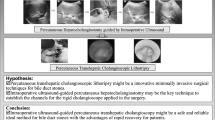Abstract
Background
The residual stones of postsurgical intrahepatic calculi have been among the most difficult problems in hepatobiliary surgery. Intraoperative ultrasound can clearly display the morphology of intrahepatic bile ducts and the distribution of calculi as well as the position of the choledochoscope and the calculus extraction instruments. Therefore, intraoperative ultrasound can guide the choledochoscope and its auxiliary equipment for calculus extraction. It is necessary to evaluate the effectiveness and safety of surgeries using an ultrasound-guided fiberoptic choledochoscope for the treatment of complicated hepatolithiasis.
Methods
The 56 cases in group A were selected from patients who had complicated hepatolithiasis treated with calculus extraction therapy using an ultrasound-guided fiberoptic choledochoscope in the authors’ hospital between January 2006 and June 2009. The 63 cases of complicated hepatolithiasis in group B were chosen from patients treated with calculus extraction surgeries using a fiberoptic choledochoscope without the guidance of ultrasound from September 2001 through December 2005. Transabdominal ultrasound, T-tube cholangiography, and computed tomography (CT) examination were performed on day 15 after the surgery to compare the complete stone clearance rate, the residual stone rate, and the incidence rate of postoperative complications between groups A and B.
Results
The intrahepatic calculi were completely removed in 53 group A cases. The complete stone clearance rate was 94.6%, and the residual stone clearance rate was 5.4%. In group B, 51 cases had complete stone removal, for a stone clearance rate of 81% and a residual stone rate of 19%. The difference in the residual stone rates between the two groups is statistically significant (p = 0.025). No hemobilia, biliary perforation, or other complications were observed in either group.
Conclusion
Use of the intraoperative ultrasound-guided fiberoptic choledochoscope in the treatment of complicated hepatolithiasis can significantly reduce the residual stone rate of intrahepatic biliary calculi and significantly improve the treatment effect of hepatolithiasis.



Similar content being viewed by others
References
Hochberger J, Tex S, Maiss J, Hahn EG (2003) Management of difficult common bile duct stones. Gastrointest Endosc Clin North Am 13:623–634
Feliciano DV, Mattox KL, Jordan GL Jr (1980) The value of choledochoscopy in exploration of the common bile duct. Ann Surg 191:649–654
Wu YW, Jian YP, Liang JS, Zhong W, Yang ZW (2006) The treatment of intrahepatic calculosis by applying helix hydro-jet lithotripsy under video choledochoscope: a report of 30 cases. Langenbecks Arch Surg 391:355–358
Cheon YK, Cho YD, Moon JH, Lee JS, Shim CS (2009) Evaluation of long-term results and recurrent factors after operative and nonoperative treatment for hepatolithiasis. Surgery 146:843–853
Chen D-W, Tung-Ping Poon R, Liu C-L, Fan ST, Wong J (2004) Immediate and long-term outcomes of hepatectomy for hepatolithiasis. Surgery 135:386–393
Shimada H, Nihmoto S, Matsuba A, Nakagawara G, Kobayashi M (1987) Experience with percutaneous transhepatic fiberoptic choledochoscopy for retained stones in the biliary tract: report on 15 patients. Surg Endosc 1:189–194
Kazuhiro O, Shuji S, Kazuo C, Takahiro O, Takashi M, Atsushi S, Koji Y, Masao T (1999) Comparison of treatments for hepatolithiasis: hepatic resection versus cholangioscopic lithotomy1. J Am Coll Surg 189:177–182
Yi-Yin J, Miin-Fu C (1995) Percutaneous trans-hepatic cholangioscopic lithotomy for hepatolithiasis: long-term results. Gastrointest Endosc 42:1–5
Yeh YH, Huang MH, Yang JC, Mo LR, Lin J, Yueh SK (1995) Percutaneous trans-hepatic cholangioscopy and lithotripsy in the treatment of intrahepatic stones: a study with 5 year follow-up. Gastrointest Endosc 42:13–18
Stage JG, Rasmussen SG, Kock JP, Movild B, Kehlet H (1991) Percutaneous cholecystostomy and laser lithotripsy. Ugeskr Laeger 153:200–201
Makuuchi M, Torzilli G, Machi J (1998) History of intraoperative ultrasound. Ultrasound Med Biol 24:1229–1242
Li F, Cheng J, He S, Li N, Zhang M, Dong J, Jiang L, Cheng N, Xiong X (2005) The practical value of applying chemical biliary duct embolization to chemical hepatectomy for treatment of hepatolithiasis. J Surg Res 127:131–138
Siewert B, Kruskal JB, Kane RA (2006) Intraoperative sonography of the biliary system. Ultrasound Clin 1:521–531
Disclosures
Weidong Pan, Erjiao Xu, Heping Fang, Meihai Deng, and Ruiyun Xu have no conflicts of interest or financial ties to disclose.
Author information
Authors and Affiliations
Corresponding author
Rights and permissions
About this article
Cite this article
Pan, W., Xu, E., Fang, H. et al. Surgical treatment of complicated hepatolithiasis using the ultrasound-guided fiberoptic choledochoscope. Surg Endosc 25, 497–502 (2011). https://doi.org/10.1007/s00464-010-1200-1
Received:
Accepted:
Published:
Issue Date:
DOI: https://doi.org/10.1007/s00464-010-1200-1




